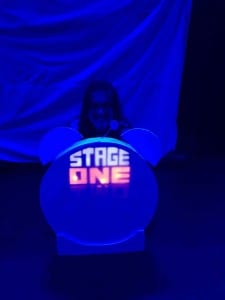Hello everyone! Today’s blog post is going to be all about verbatim theatre.
Verbatim theatre, or word for word theatre is “a form of theatre firmly predicated upon the taping and subsequent transcription of interviews with ‘‘ordinary’’ people” (Paget, 1987, 317). This is what The Truth About Bedtime… is grounded in, the real words gathered in interviews about individual experiences of sleep. And they vary from night terrors to sex dreams. Our performance includes four scenes about sleep disorders: insomnia, night terrors, lucid dreaming and sleep paralysis, and these scenes all feature a combination of physical theatre and verbatim. In using the words of real people, for these sections in particular, we aimed to provide our audience with a range of experiences, allowing them to sympathise and empathise with people who they do not know, but whose stories are manifested on stage.
Before editing the verbatim sections of the piece, we first had to transcribe the interviews that we had conducted. Typing up these interviews was more difficult that it at first seemed, as I had to devise a key so that the actors were able to recognise changes in the interviewee’s voice whilst reading the text. The basic key is as follows: italics for speeding up, bold and capitalisation for emphasis, underlining for inflection. The interviews also had to be typed exactly in the way which they were said, so that accent as the elongation of words could be distinguished.
For example, the following audio is an extract from one of the interviews I conducted.
And this snippet was transcribed as: “you know if I, if I am suffering from, um insomnia it’s not usually that I can’t get to sleep it’s that I wake up, in the night, and then can’t get back to sleep. Or I wake up very early (low) and can’t get back to sleep. Umm… and, my mind is just racing with RIDiculous things, so it could be as ridiculous asssss, did I buy butter? Or, yu know, jus really really ridiculous things, that, actually, don’t matter at all? But in the middle of the night my mind is just wEYEired, an it’s just du du du du du du du du du du du du du ad it’s just all these random thoughts all over the place and I just can’t shut them up.”
In the process of creating verbatim theatre, “the words of real people are recorded or transcribed by a dramatist during an interview or research process… and then edited, arranged or recontextualised to form a dramatic presentation” (2008, Hammond and Steward, 9). We aimed to conduct all of our interviews in a comfortable and safe environment where our participants would feel at ease; mostly they were done in cafes. Our interviewees were asked to fill out one of our consent forms, to ensure that they knew how their words would be used and that they had to right to withdraw what they said in their interviews. Alongside this, all of our interviewees were invited to attend a work-in-progress show at the beginning of May so that that could see how we had used their words and thank them for their contributions.
An issue that I have faced when editing these interviews into concise sections within our piece is where to stop and draw the editing line, if you will. As with all verbatim theatre, I have sometimes had to “change the sequence of elements in a person’s testimony, remove contextual information, and create connections which did not exist in the interviews themselves” (Young, 2017, 29-30) in order to create a dramatic narrative. However, when doing this I have also been conscious of the people who have trusted us with their words and the context in which they were said. I wanted to remain as true as possible as I could to the original interviews to ensure that nothing was misconstrued. Alecky Blythe, a particularly famous verbatim playwright, claims to be “faced with the same struggle between remaining faithful to the interview and creating a dramatic narrative” (Blythe, 2008, 94). Though our participants were made aware in their consent forms that their words “might be used in full, in part, or not at all, and… might be merged with the words of other participants, and they may also be included in passages that are completely fictional” this struggle about being faithful towards the interview still applied. In my editing, though I have moved words around and merged them with the words of other participants, I have avoided writing fictional passages. I believe that when we have had so many people willing to participate, it would be a shame to write our own words just for ease. Therefore, in writing sections such as insomnia, where passages from interviews are connected by a like word, I have ensured that these connections are found organically where possible.
Though I cannot say these interviews are unedited, with contexts removed and meanings slightly altered, I have attempted to ensure that the essence of each interviewee’s words is not tampered with. I hope that this will come across in the final performance.
E.W.
Works Cited:
Blythe, A. (2008) Alecky Blythe. In: Hammond, W and Steward, D (eds.) Verbatim verbatim: contemporary documentary theatre. London: Oberon Books, 77-103.
Hammond, W and Steward, D. (2008) Introduction. In: Hammond, W and Steward, D (eds.) Verbatim verbatim: contemporary documentary theatre. London: Oberon Books.
Paget, D. (1987) ‘Verbatim Theatre’: Oral History and Documentary Techniques. New Theatre Quarterly, 3(12) 317-336.
Stuart, Y. (2017) The Ethics of the Representation of the Real People and Their Stories in Verbatim. Themes in Theatre — Collective Approaches to Theatre & Performance, 9, 21-43.
White, M. (2018) Menopausal Insomnia. Interviewed by E. White, 2 April.
